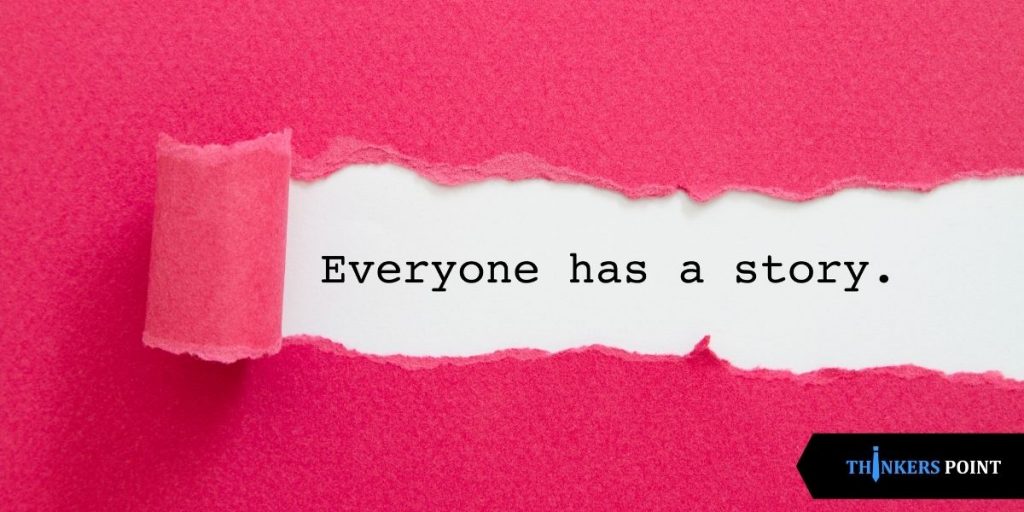Meaning Of Storytelling Skills
Stories are an efficient way of presenting your imagination, thoughts, feelings, and ideas to people. they need the ability to inspire, motivate, and alter your opinions. Telling stories has always been proved to be the foremost efficient way of communication. Storytelling has become the business buzzword since the eruption of advertising, but now, this skill isn’t limited to sales and marketing only.
Storytelling is the creative art of narrating and describing the social activity and cultural activity and work of sharing stories and narratives, sometimes with improvisation, theatrics, or embellishment. Every culture and habitat has its own stories and narratives, works, or narratives, which are shared as to how of good entertainment, high education, cultural preservation, or instilling moral values. Crucial elements of stories and storytelling include the plot of the story, the characters in the story, and the narrative point of view of the author.
The term “storytelling” usually refers to a narrow and limited sense specifically to oral and verbal storytelling and also in an exceedingly looser and ordinary sense to techniques utilized in media to unfold, reveal or disclose the narrative of a story.
Storytelling has importance in business, it is employed to remain connected to your colleagues, staff, suppliers, partners, and team members. it’s the inspiring thanks to changing opinions of your employees or help them achieve the goals which are considered to be impossible by them.
The only way within which business stories differ from other stories is that they need to get some motivation, vision, and objective at the tip and that they aren’t for entertainment, unlike other stories.
Techniques Of Storytelling
Storytelling is one of the marketing world’s new darlings. It’s a marketing strategy that has made its way into everywhere from board rooms to mom and pop stores. Storytelling is even being hailed because of the only most powerful business skill for the subsequent decade.

Unfortunately, storytelling, as applied to business, can seem a little amount lofty – more kind of an idea than a tactic. That’s very true if you’re not a Fortune 500 company with a multi-million dollar allow television commercials.
So does storytelling apply to smaller businesses? Can storytelling be practical? during a very word: Yes.
Storytelling is the oldest because to deliver a message – or to clarify the earth. Ancient peoples used storytelling. The Bible uses storytelling. Your uncle uses storytelling. You’re using storytelling for yourself and your business, whether or not you don’t call it exactly that.
Storytelling is one of the oldest sorts of communication.
You’re already a storyteller, but it’s always good to reinforce your skills. So here we are presenting seven techniques to help you explain and describe yourself and your business better. Even some tweaks to your story can deliver major results.
But just knowing the thanks to being a much better storyteller isn’t enough. So I’ve listed five areas of your business that you simply just can apply your new storytelling skills to. These address and introduce very specific goals, like getting more and more readers to your blog, explaining and describing what your company does, and attracting ideal employees.
Storytelling can appear to be a lofty, magical topic, but it’s one altogether the sole, oldest ways to push anything. you’ll find you even prefer it.
Here we are presenting you with seven storytelling techniques:
1. Have an Enemy and a Hero
Stories need an honest guy and a nasty guy – also called a hero and an enemy. The enemy could also be a thing, kind of a desert or “the system” or perhaps a fear within the hero. The arc and base of the story are how the hero and protagonist beat the enemy.
Questions to ask yourself about storytelling might include: What is the core enemy of my customers or clients? Is it a danger? Wasted money? Unfulfilled dreams? Bad hair?
2. Use Conflict
Conflict is described as how the friction between the enemy and the protagonist manifests. Maybe it shows up because the hero decided to cross the desert, or after you, the business owner decided to figure out how to defeat an issue. Conflict also describes the obstacles you encountered on your because of success, whether or not they were problems alongside your bank or with a tornado. If the hero has no struggle and hard work, then it’s a lame story.
3. Omit any Irrelevant Detail
Omit and remove any detail that doesn’t help to move the story forward or develop the characters. This is often about keeping the readers’ attention. If they don’t must realize your red bicycle to understand the arc of your story, don’t tell them about the bicycle. If they don’t need to know what reasonably awesome, high-tech sneakers you accustom to cross the desert, don’t tell them about the sneakers.
4. Tell the Story as you Talk
This one’s pretty simple. Corporate-speak ruins stories. Talk like you’d normally talk. If you sound slightly too corporate to pass as a median person, hire a storyteller.
Visual stories are a very powerful weapon to convey and present a message. Add visual elements and props to your business storytelling to make it more convincing.
5. Make It Visual
There’s a reason children’s storybooks are mostly pictures, which such an enormous amount of the simplest stories ever told are made into movies. Images bring a story to life. you’ll tell a story just by standing up and talking, but it had better be one heart-clutches of a story. And even after that, images added by you will make it more powerful.
6. Make It Personal, Creative & Easy to Relate To
To instantly borrow from the last point: Use images of what actually happened, or where it happened. Use images of the 000 people within the story, not stock photo models.
And again, talk like you talk. Show your personality. Reveal slightly of your weaknesses and your fears. Everybody else has those weaknesses and fears, too. This leverages a subtle power of storytelling: after we tell our own story, often we are telling other people’s stories too. Those people will be your ideal audience, and your ideal customers and clients.
7. Add Surprise
A story with no surprises is boring. You knew this already (because you’re already a storyteller, remember?), but it bears repeating. Whether it’s an honest surprise or a nasty surprise, every joke features a minimum of 1 surprise. this will be important to a story as a conflict.
Importance Of Storytelling Skills
1. Straight facts are forgettable and boring. If you are attempting to influence someone through facts like graphs and statistics, you’re visiting have a tough time.
2. Stories can hide your message. after you hear a story, you think about the plot, not the underlying point. This why lots of advertisements use storytelling as some way to convince you to shop for their product.
3. Stories can subtly persuade you. Often you’ll barely notice what the story is trying to mention so you have got no position to argue against.
4. you’ll be able to build a reference to others through stories. Through this connection, you’ll build rapport and trust. These are two big qualities to own when influencing others.
5. Emotions are central to good storytelling. Emotions are useful for building strong memories of what’s being said and strengthening whatever message you‘re trying to urge across.
6. It’s an honest thanks to getting someone to recollect what you’ve said. Someone being attentive to a story is engaged as a lively listener.
Historical Perspective Of Storytelling
Storytelling predates writing. The earliest varieties of storytelling were usually oral combined with gestures and expressions. additionally, to being a neighborhood of spiritual rituals, some archaeologists believe rock art may have served as a kind of storytelling for several ancient cultures. The Australian aboriginal people painted symbols from stories on cave walls as a way of helping the storyteller remember the story. The story told then was a mixture and combination of oral music, narrative, rock art, and dance, which bring a deep understanding and meaning of human existence on earth through remembrance and enactment of stories. People used the creatively carved trunks of living trees and ephemeral media (such as sand and leaves) to record stories in pictures or with writing. Complex types of tattooing may additionally represent stories, with information about genealogy, affiliation, and social station.
With the appearance of writing and therefore the use of stable, portable media, stories were recorded, transcribed, and shared over wide regions of the globe. Stories are carved, embedded, painted, scratched, printed or inked onto wood or bamboo, ivory and other bones of animals, pottery, clay tablets, stone, palm-leaf books, skins (parchment), bark cloth, paper, silk, canvas, and other textile products like paper and cloth, recorded on film and stored electronically in digital form. Oral and verbal stories still are created, improvisationally by impromptu storytellers, similarly as committed to memory and passed from generation to generation, despite the increasing popularity of written and televised media in much of the globe.
Frequently Asked Questions:
Ans. Storytelling is the process of creating a reference to the customer first, and selling a product second. This method of promotion is contrary to most advertising programs, and sometimes seems more sort of a creative writing program than a marketing strategy.
Ans. The Storytelling Animal: How Stories Make Us Human by Jonathan Gottschall
You’ll Grow Out of It by Jessi Klein
Always Start With Why: How Great Leaders Inspire Everyone to Take Action by Simon Sinek
Three Women by Lisa Tadde
Break the Wheel by Jay Acunzo
Ans. Know your audience
Define your core message
Decide what reasonably story you’re telling
Establish your call-to-action
Choose your story medium
Ans. a) Plot is the most significant part of any story.
b) Characters are the weather who reside within the story.
c) Theme could be a word that will be defined during a few words.
d) Dialogue is the way how characters connect with one another and to you.
e) Audience
f) Melody
e) Decor
f) Spect
Ans. Effective storytelling involves a deep understanding of human emotions, motivations, and psychology to actually move an audience. Luckily, storytelling is a few things we all do naturally, starting at a really young age. But there is a difference between good storytelling and great storytelling.

